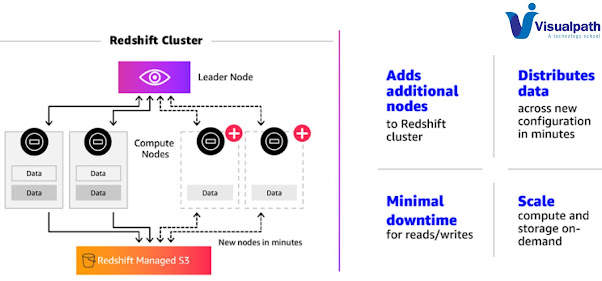Amazon Redshift | Loading & Unloading Data
Loading and unloading data in Amazon Redshift involves moving data into and out of the Redshift data warehouse. This process is essential for populating Redshift tables with data from external sources and for extracting data from Redshift tables for analysis or archival purposes.
There are several methods for loading and unloading data in
Amazon Redshift:
1. Amazon S3: Amazon S3 (Simple Storage Service) is
often used as an intermediary for loading data into and unloading data out of
Redshift. You can use the `COPY`
command to load data from files stored in S3 into Redshift tables, and the `UNLOAD` command to extract data from
Redshift tables and store the results as files in S3.
2. Amazon DynamoDB: If your data
resides in DynamoDB, you can use the AWS Data Pipeline service or AWS Glue to
transfer data from DynamoDB tables
to Redshift. - Amazon
Redshift Online Training
3. AWS Data Pipeline: AWS Data Pipeline
is a web service for orchestrating and automating the movement and
transformation of data across AWS services. You can use Data Pipeline to
schedule and automate the loading and unloading of data between Redshift and
various data sources such as S3,
DynamoDB, RDS, etc.
4. AWS Glue: AWS Glue is a fully managed extract, transform, and load
(ETL) service that makes it easy to prepare
and load data for analytics. You can use AWS Glue to crawl your data sources, generate schema definitions, and transform
data before loading it into Redshift.
5. Direct Data Loading: For smaller
datasets or one-time data loads, you can use tools like the Redshift COPY command, which can load
data directly from files on your local machine or from Amazon S3 into Redshift
tables.
6. Third-party ETL Tools: There are also
third-party ETL (Extract, Transform, Load) tools available that support Amazon
Redshift, such as Informatica, Talend,
Matillion, etc. These tools provide graphical interfaces for designing data
workflows and integrating with various data sources and targets, including
Redshift.
When unloading data, it's crucial
to consider the format and structure of the output files, as well as any data transformation or filtering
requirements. Similarly, when loading data, you need to ensure that the data is
in a compatible format and that any necessary transformations or data cleaning
steps are performed before loading it into Redshift. Additionally, you should
consider Redshift's distribution styles
and sort keys to optimize query
performance. - Amazon
Redshift Certification Online Training
Visualpath is the Leading and Best Institute for learning Redshift Training in Hyderabad. We provide Amazon Redshift Online
Training, you will get the best course at an affordable cost.
Attend Free Demo Call on - +91-9989971070.
Visit Our Blog: https://amazonredshiftonlinetraining.blogspot.com/
Visit: https://www.visualpath.in/amazon-redshift-online-training.html



Comments
Post a Comment